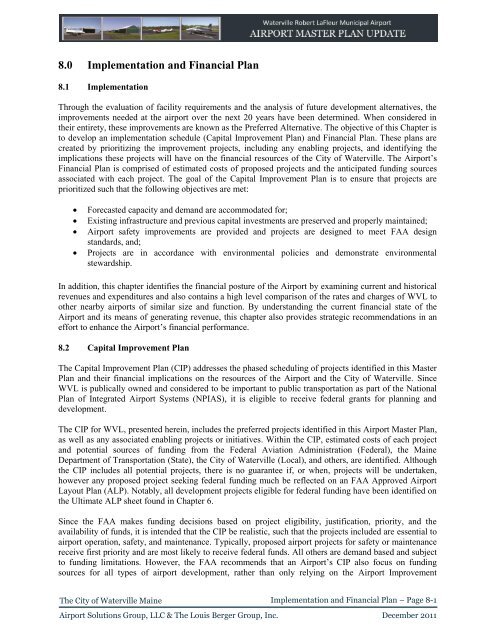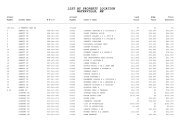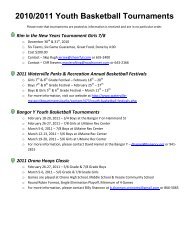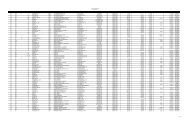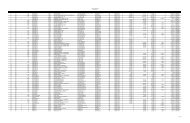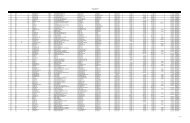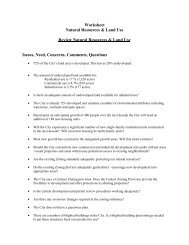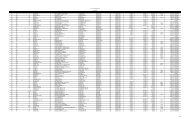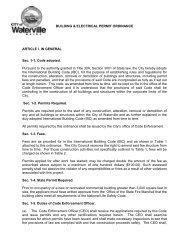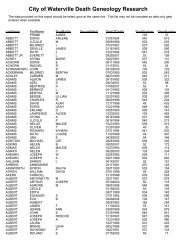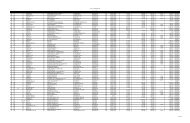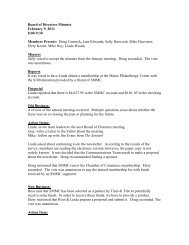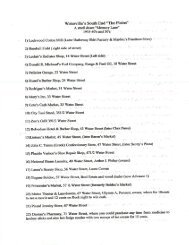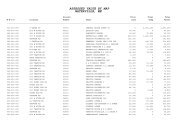Airport Master Plan 2012 - City of Waterville
Airport Master Plan 2012 - City of Waterville
Airport Master Plan 2012 - City of Waterville
You also want an ePaper? Increase the reach of your titles
YUMPU automatically turns print PDFs into web optimized ePapers that Google loves.
8.0 Implementation and Financial <strong>Plan</strong><br />
8.1 Implementation<br />
Through the evaluation <strong>of</strong> facility requirements and the analysis <strong>of</strong> future development alternatives, the<br />
improvements needed at the airport over the next 20 years have been determined. When considered in<br />
their entirety, these improvements are known as the Preferred Alternative. The objective <strong>of</strong> this Chapter is<br />
to develop an implementation schedule (Capital Improvement <strong>Plan</strong>) and Financial <strong>Plan</strong>. These plans are<br />
created by prioritizing the improvement projects, including any enabling projects, and identifying the<br />
implications these projects will have on the financial resources <strong>of</strong> the <strong>City</strong> <strong>of</strong> <strong>Waterville</strong>. The <strong>Airport</strong>’s<br />
Financial <strong>Plan</strong> is comprised <strong>of</strong> estimated costs <strong>of</strong> proposed projects and the anticipated funding sources<br />
associated with each project. The goal <strong>of</strong> the Capital Improvement <strong>Plan</strong> is to ensure that projects are<br />
prioritized such that the following objectives are met:<br />
<br />
<br />
<br />
<br />
Forecasted capacity and demand are accommodated for;<br />
Existing infrastructure and previous capital investments are preserved and properly maintained;<br />
<strong>Airport</strong> safety improvements are provided and projects are designed to meet FAA design<br />
standards, and;<br />
Projects are in accordance with environmental policies and demonstrate environmental<br />
stewardship.<br />
In addition, this chapter identifies the financial posture <strong>of</strong> the <strong>Airport</strong> by examining current and historical<br />
revenues and expenditures and also contains a high level comparison <strong>of</strong> the rates and charges <strong>of</strong> WVL to<br />
other nearby airports <strong>of</strong> similar size and function. By understanding the current financial state <strong>of</strong> the<br />
<strong>Airport</strong> and its means <strong>of</strong> generating revenue, this chapter also provides strategic recommendations in an<br />
effort to enhance the <strong>Airport</strong>’s financial performance.<br />
8.2 Capital Improvement <strong>Plan</strong><br />
The Capital Improvement <strong>Plan</strong> (CIP) addresses the phased scheduling <strong>of</strong> projects identified in this <strong>Master</strong><br />
<strong>Plan</strong> and their financial implications on the resources <strong>of</strong> the <strong>Airport</strong> and the <strong>City</strong> <strong>of</strong> <strong>Waterville</strong>. Since<br />
WVL is publically owned and considered to be important to public transportation as part <strong>of</strong> the National<br />
<strong>Plan</strong> <strong>of</strong> Integrated <strong>Airport</strong> Systems (NPIAS), it is eligible to receive federal grants for planning and<br />
development.<br />
The CIP for WVL, presented herein, includes the preferred projects identified in this <strong>Airport</strong> <strong>Master</strong> <strong>Plan</strong>,<br />
as well as any associated enabling projects or initiatives. Within the CIP, estimated costs <strong>of</strong> each project<br />
and potential sources <strong>of</strong> funding from the Federal Aviation Administration (Federal), the Maine<br />
Department <strong>of</strong> Transportation (State), the <strong>City</strong> <strong>of</strong> <strong>Waterville</strong> (Local), and others, are identified. Although<br />
the CIP includes all potential projects, there is no guarantee if, or when, projects will be undertaken,<br />
however any proposed project seeking federal funding much be reflected on an FAA Approved <strong>Airport</strong><br />
Layout <strong>Plan</strong> (ALP). Notably, all development projects eligible for federal funding have been identified on<br />
the Ultimate ALP sheet found in Chapter 6.<br />
Since the FAA makes funding decisions based on project eligibility, justification, priority, and the<br />
availability <strong>of</strong> funds, it is intended that the CIP be realistic, such that the projects included are essential to<br />
airport operation, safety, and maintenance. Typically, proposed airport projects for safety or maintenance<br />
receive first priority and are most likely to receive federal funds. All others are demand based and subject<br />
to funding limitations. However, the FAA recommends that an <strong>Airport</strong>’s CIP also focus on funding<br />
sources for all types <strong>of</strong> airport development, rather than only relying on the <strong>Airport</strong> Improvement<br />
The <strong>City</strong> <strong>of</strong> <strong>Waterville</strong> Maine<br />
Implementation and Financial <strong>Plan</strong> – Page 8-1<br />
<strong>Airport</strong> Solutions Group, LLC & The Louis Berger Group, Inc. December 2011


